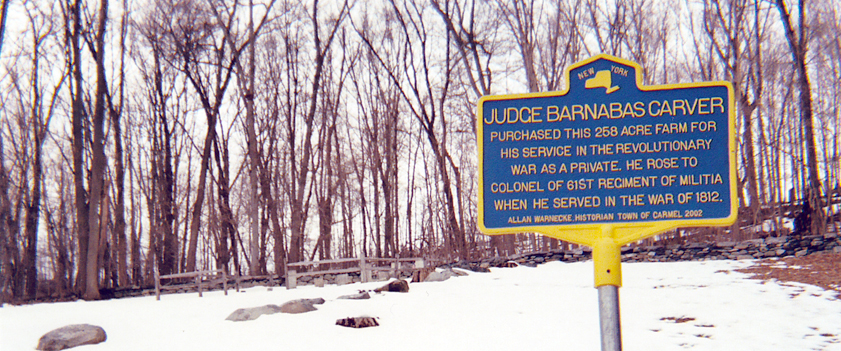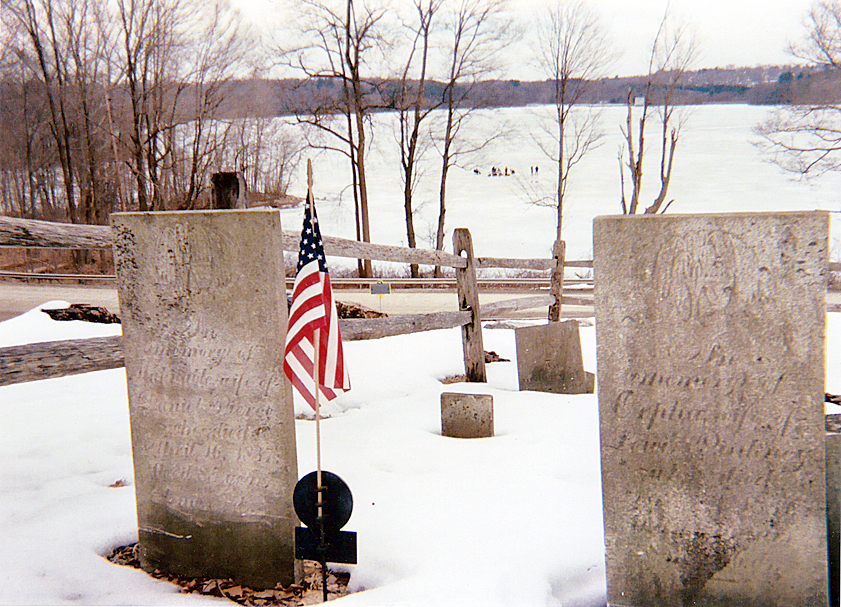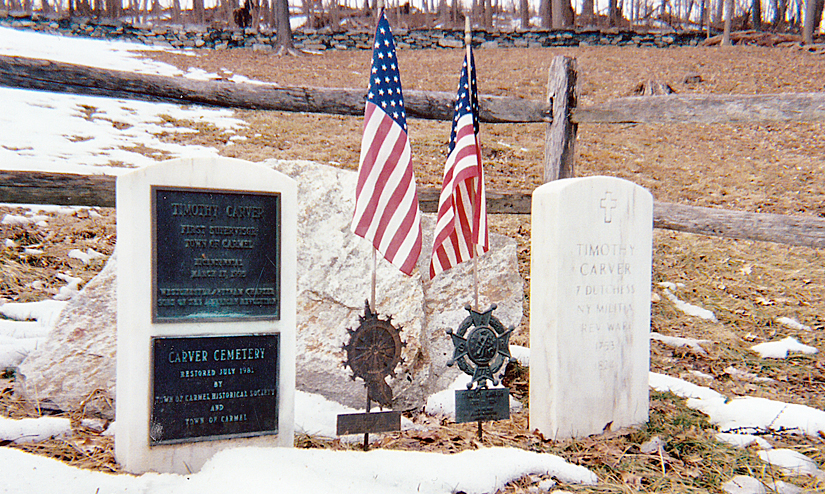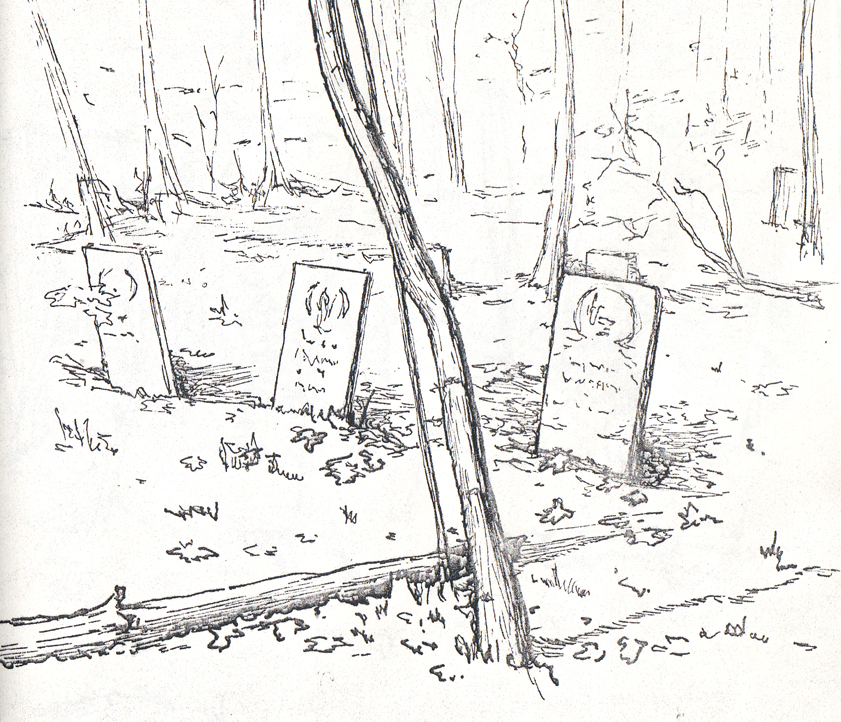
Carmel
Bailey
Ballard-Barrett
Barrett
Belden
Carver
Cole
Crane
Fowler
Gilead
Gregory
Hill
Hughson
Kelley
Mt. Carmel Baptist
Old Baptist
Old Methodist
Old Presbyterian
Raymond Hill
Union Valley
Carver Cemetery (a.k.a. NYC Watershed Plot; Chase Cemetery)
Carmel, NY
 (other photos at bottom of page)
(other photos at bottom of page)
| Current Status: | |
| Description: | "Near Secords Corners... These bodies were removed from Carver Plot, at Coles Mills, when making the basis for storage reservoir at Kent (sic)." - Horton. Called the "Chase Cemetery" on tax lists, 1927-2008. Monuments at the west side of the road are to Timothy Carver, who might have been buried in this cemetery. Some graves probably moved elsewhere, including Revolutionary War veteran Capt. Joseph Dykeman. It may have been associated with the Drewville Chapel of the Drew Methodist Church, which is also gone, but that was not built until well after the days when fieldstone graves predominated. |
| GPS: | N41° 24.695' W073° 42.641' |
| Location: | On the hillside on Washington Road, about 200' west of that road about 250' before it breaks away from the reservoir and starts uphill. "Records prove this one did exist, but the exact location is doubtful. A probable location is where the reservoir is now." - Fisher |
| How To Access: | 221 Washington Road, about .85 mile north of Route 6, about 250' south of stream; cemetery set back uphill from the road. |
| Tax Map No.: | 54-1-32 |
| Owner of Record: | |
| Size & Use: | |
| Earliest Gravestone: | Rachel Yeamans, d. Nov. 1830. |
| Most Prominent: | |
| Current Condition: | |
| Maintained By: | Town of Carmel |
| Repairs Needed: | |
| Troy #: | 1D |
References: Pelletreau p.359; Frost; Horton p. 123; Fisher p.31; Fisher #38; Buys p.151.
Click on a name below for photo of headstone and location in cemetary. Below the list of names is a brief history of Timothy Carver, first Carmel Town Supervisor. Some of his relatives are buried in this cemetery.
| ABBOTT |
|
|
| CARVER |
|
|
| COLE |
|
|
| GANUNG |
|
|
| PIERCE |
|
|
| PINCKNEY |
|
|
| YEOMANS/YEAMANS |
|
| The cemetery includes other fieldstone markers, uninscribed. |
Timothy Carver was born on October 30, 1753 in Bridgewater, Massachusetts. He came to Frederickstown (Carmel), New York as a young child in the 1750's. His parents, Timothy Sr. and Rebecca Washburn Carver, established a homestead on the north side of Long Pond where they raised their family. In addition to Timothy Jr., the other children were Rebecca, Mehitable, Barnabus and Thankful.
Timothy Carver Sr. died sometime before 1776 in Frederickstown. In 1776 Timothy Carver married Phebe Baldwin, daughter of James and Hannah Golden Baldwin. They had a very large family, even for that time, consisting of 14 children. They were Jonathan (1777-1783), Mary (1774-1799), Rebecca (1780- ), James (1781-1837), Elijah (1783-1854), Hannah (1785-18e5), Mehitable (1785-1859), Eleazer (1788-1873), Barnabus (1790-1876), Sally (I7gt- ), John (179e-187t), Lewis (1794-1861), Zilla (1795-1880) and Rachel (1797- 1810).
When Timothy Carver's wife Phebe died on March 14, 1797, he married her sister, Hannah Baldwin, and had 2 more children. They were Daniel (1799-) and Henry (1804-1872).
Sometime around 1815 all of Timothy Carver's sons left Carmel for the State of Indiana, except for his son James. This meant that the Carver Homestead was passed to him. This was a farm of about 350 acres located on the north shore of Long Pond all the way to the water's edge. From the west end of Long Pond the property line extended across Long Pond Road near Old Long Pond Road, then in a straight line all the way to the top of Hitchcock Hill. The line then meandered northeast to the top of Turkey Hill and then south on a line parallel to Dixon Road, through what is now Sycamore Park, and on the east end of Long Pond. Today the Carver Homestead would include the Long Pond Inn, Curry Road and Blueberry Hill. The actual homesite was diagonally across the road and slightly up the hill from the entrance to Sycamore Park.
James Carver became a party in one the most famous court cases of the day in Putnam County. As was the case for many farms in the Town of Carmel, the Carver Homestead was purchased through the Committee of Forfeiture and Sales that followed the Revolutionary War. These lands were confiscated from the Phillipse family who were British sympathizers during the war. In 1787 the Philipse family went to court to get their land back. Not much happened until 1809 when new farmers in the western end of the Town of Carmel, Lot #5 from the old Phillipse deeds. The case was tried in the United States Circuit Court in New York where many local people from Carmel gave testimony. However, Astor prevailed but the case was taken all the way to the United States Supreme Court. In 1830 a final settlement was reached where Astor received a cash payment from New York State and the local farmers were able to keep their land.
Timothy Carver is probably best known as the first Supervisor of the newly created Town of Carmel in 1791. However he was active in public service both before and after he was in that office. Starting in 1744 he held the office of Constable and he was also Tax Collector. After his one year term as Town Supervisor, he was appointed to the school board; all this when he was farming and raising a family that included 14 children.
On the night of November 3, 1824 Timothy Carver died by drowning in a fall from Carver Bridge. The bridge was located on the road between Carmel village and Long Pond, specifically between the farms of Judge Barnabus Carver and Phillips Smith. He was probably buried in Carver Cemetery which was located on the farm of Barnabus Carver, but no gravestone or record of same was ever found. We do not know for certain where Timothy Carver or either of his two wives are buried. We do know that Barnabus Carver and his wife were buried there as well as 2 of Timothy Carver's sisters, Thankful Carver Abbott and Mehitable Carver Pierce. Rebecca Carver Hughson and her husband are buried in Gilead Cemetery in Carrnel.
In 1895 the City of New York built a dam across the West Branch of the Croton River to create the West Branch Reservoir of the New York City water supply. Many farms were flooded by this action as well as Carver Bridge and Carver cemetery. Most of the old gravestones from Carver Cemetery were moved up on a hill about one quarter mile west to what is today referred to as Carver Cemetery or New York City Watershed Plot. However, not all the old stones were moved to this location. Barnabus Carver for example, was moved to Raymond Hill Cemetery in Carmel and others were moved to unknown locations. It is possible that Timothy Carver falls into this catagory, but it seems more likely that he never had a gravestone.
Carver Bridge has remained under about 50 feet of water to this day. As part of the Town of Carrnel Bicentennial celebration several community organizations banded together to do some underwater archeology with the goal of finding Carver Bridge. The Mahopac Falls Fire Department Underwater Search and Rescue Team made a dive on May 15, 1995 and investigated a small area of the bottom of the reservoir where the bridge had been located on old maps. The divers visibility was only 7 feet and the bridge was not found in the short time period New York city had allowed for the investigation. [It was found on a later dive.]
Timothy Carver was a Patriot during the War for Independence. Since Frederickstown and even later Carrnel, until 1812, were in Dutchess County, Timothy Carver joined the local regiment. This was the 7th Dutchess County Regiment of the New York Militia which was a unit of Minutemen. It was under the command of Colonel Henry Ludington and Lieutenant-Colonel Reuben Ferris. There were about 500 to 700 officers and men in the regiment who were farmers drawn from an area that makes up most of what is now Putnam County. They were tested early in the battle of White Plains in the Autumn of 1776.
This is the regiment made famous by the Colonel's teenage daughter, Sybil Ludington. When the British attacked Danbury, Connecticut in the Spring of 1777, the call came for the 7th Dutchess County Regiment, but the Colonel had no one to ride to call out his troops. His daughter Sybil, then only 16 years old, volunteered to make the dangerous nightime ride.
It is not known the exact route that she followed that night, but it seems likely that part of the trip took her west from the village of Carmel over what is now Route 301 to Dixon Road; then south over the hill to Crane Road, right past Long Pond to Hill Street and on to Red Mills. It is therefore likely that on the night of April 6, 1777 Timothy Carver, father of our town, got a wake-up call from our local heroine Sybil Ludington.
(Source: Allan J. Warnecke County Historian, May 28, 1995)


